Ever wondered how plants get the food they need? It’s more than just soil and water. You’ll find that plant nutrition is complex and fascinating. It involves photosynthesis, a key part of plant growth.
Understanding plant nutrition helps us see why healthy soil is vital. It provides plants with the nutrients they need to grow well.
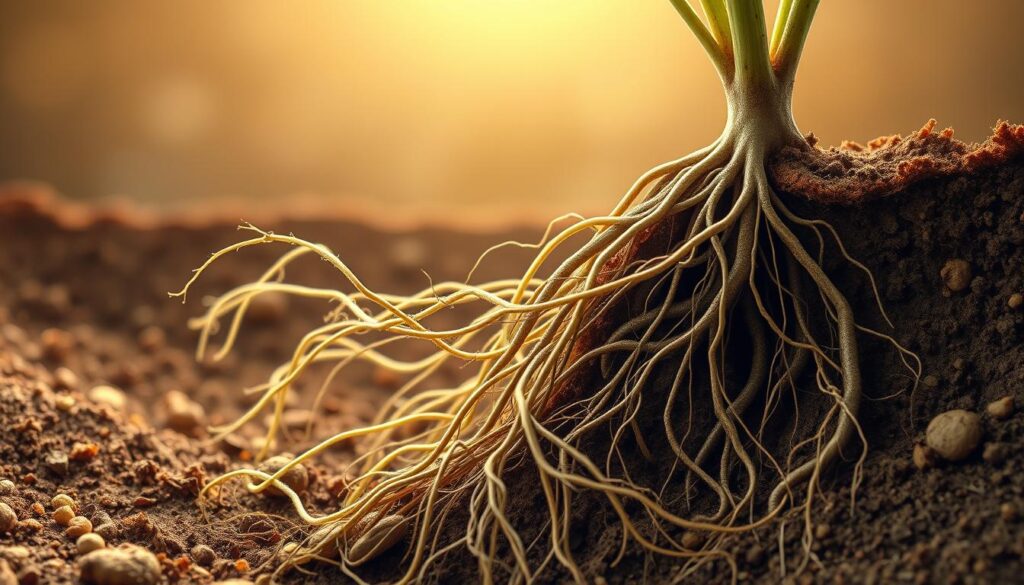
Exploring plant nutrition, you’ll learn how plants get essential nutrients. You’ll see how healthy soil helps plants grow. It can even help plants grow well without harmful chemicals.
So, let’s dive into the world of plant nutrition. We’ll uncover the secret to how plants get nourished. We’ll look at the importance of photosynthesis in plant growth.
Key Takeaways
- Plant nutrition is a complex process that involves more than just soil and water.
- Photosynthesis process is a crucial aspect of plant growth and nutrition.
- Healthy soil plays a critical role in providing plants with the necessary nutrients for optimal growth.
- Understanding how do plants get food is essential to appreciating the importance of plant nutrition.
- Plant nutrition involves a range of factors, including soil, water, and photosynthesis process.
- Healthy soil can produce high yields without harmful chemical inputs, making it an essential aspect of sustainable agriculture.
Understanding the Basics of Plant Nutrition
Plant nutrition is a complex process. It involves the absorption of nutrients and water through the root system. Essential nutrients for plants include nitrogen, phosphorus, and potassium. These are crucial for growth and development.
Plants need about 20 elements for their biochemical needs. These include carbon, hydrogen, oxygen, nitrogen, phosphorus, and potassium. They get these elements from the soil, water, and air. These elements are vital for photosynthesis, respiration, and other cellular processes.
The process of plant nutrition involves the uptake of nutrients from the soil. These nutrients are then transported to the rest of the plant. This process is key for plant growth and development. It is influenced by soil quality, climate, and water availability.
By understanding the basics of plant nutrition, you can provide your plants with the right nutrients. This ensures optimal growth and development.
Some key factors that affect plant nutrition include:
- Soil quality: The type and quality of soil can affect the availability of nutrients for plants.
- Climate: Temperature, light, and water availability can all impact plant nutrition.
- Water availability: Plants need adequate water to absorb nutrients from the soil.
How Do Plants Get Food? The Complete Process
Ever wonder how plants get their food? It’s all about the plant root system. This system pulls water and nutrients from the soil. These are key for the plant’s growth and health.
The process of how plants get food is quite complex. First, the roots absorb water and nutrients like nitrogen and potassium. Then, the plant uses sunlight to turn these into glucose. This glucose fuels the plant’s growth.

Light, water, and air are also vital for plants. They need light for photosynthesis, which turns sunlight into energy. Water helps move nutrients and sugars around the plant. And, air is needed for respiration, where the plant releases energy from glucose.
Knowing how plants get food is key for growing healthy plants. By giving them the right nutrients, water, and light, you help them thrive. Whether you’re a pro gardener or new to it, understanding the plant root system is crucial.
| Essential Nutrients for Plants | Role in Plant Growth |
|---|---|
| Nitrogen | Promotes leaf growth and development |
| Phosphorus | Supports root development and flower production |
| Potassium | Helps with overall plant health and resistance to disease |
The Magic of Photosynthesis
Exploring plant nutrition leads to the amazing world of photosynthesis. This process is key to plant growth. It’s vital to grasp how it works.
Photosynthesis turns light energy into chemical energy. This energy powers plant growth. It’s crucial for plant survival and life on Earth.
The light energy conversion in photosynthesis is incredible. It uses light to change carbon dioxide and water into glucose and oxygen. This process supports plant growth and keeps our ecosystem balanced.
Photosynthesis also helps control the Earth’s CO2 levels. This is essential for a healthy environment.
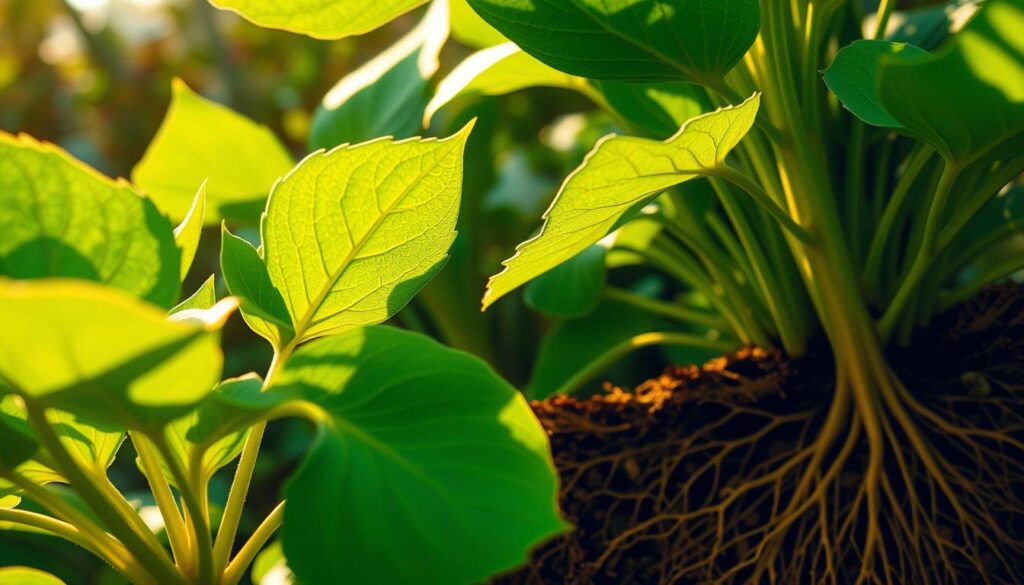
- It’s estimated that terrestrial plants produce around 120 billion metric tons of biomass through photosynthesis annually.
- The process of photosynthesis accounts for about 50% of the oxygen present in the Earth’s atmosphere.
- Approximately 30% of the carbon dioxide produced by human activities is absorbed by terrestrial plants through photosynthesis.
Learning about photosynthesis helps you care for your plants better. It shows the vital role plants play in our ecosystem. The light energy conversion and carbon dioxide use in photosynthesis are fascinating.
Understanding Your Plant’s Root System
Exploring plant nutrition reveals the vital role of the root system. It’s key for absorbing nutrients needed for growth. Plants in containers often need more fertilizer because potting mixes lack nutrients.
The root system is made to grab as many nutrients as possible from the soil. It does this with a wide network of roots searching for water and nutrients. Knowing how your plant’s roots work helps you care for them better. For example, using perlite in substrates can boost aeration and help roots stay healthy.
Important things to think about for your plant’s root system include:
- Ensuring enough water and nutrients for growth
- Using root boosters early to grow more roots
- Repotting into bigger pots to avoid root-bound issues
Understanding your plant’s root system and its role in nutrient absorption is crucial. It supports healthy growth and lets your plants reach their full potential. Whether in containers or the ground, a good root system is key for nutrient absorption.
The Soil-Plant Relationship
Understanding how soil and plants work together is key to keeping plants healthy. Soil’s structure and nutrients are vital for plant growth. A good soil structure lets roots grow deep, reaching more nutrients and water.
The aim is to have soil that drains well and has a neutral pH. This helps plants thrive.
Organic matter in soil offers many benefits. It makes soil better, holds more water, and gives plants nutrients. It also helps microorganisms grow, which are important for breaking down organic matter and making nutrients for plants.
To improve soil health, you can add compost, rotate crops, and use cover crops. These methods help a lot.
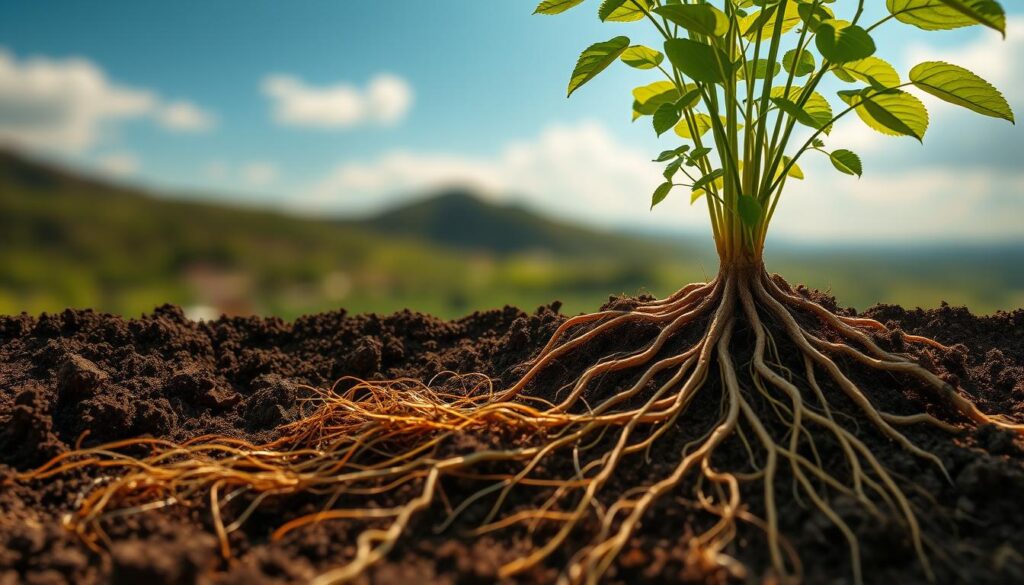
Microorganisms like bacteria, fungi, and nematodes also play a big role. They help plants by breaking down organic matter and making minerals and nitrogen available. A diverse group of microorganisms is crucial for a balanced ecosystem.
Several factors impact the soil-plant relationship. These include:
- Soil pH
- Soil structure and nutrition
- Organic matter content
- Microorganism activity
By managing these factors, you can create a healthy soil-plant relationship. This leads to better plant growth and more productivity.
Essential Macronutrients for Plant Growth
Exploring plant nutrition reveals the vital role of macronutrients in growth. Plants need about 20 essential elements, with 50% being macronutrients. The dry weight of a plant cell is mostly carbon, showing carbon’s key role in growth.
Primary nutrients like nitrogen, phosphorus, and potassium are key for growth. Nitrogen helps with chlorophyll and leaf growth. Phosphorus supports strong roots and fruit development. Potassium helps with water and nutrient transport.
Secondary nutrients like calcium, magnesium, and sulfur are also crucial. They aid in cell walls, protein, and photosynthesis. Without them, plants may grow slowly or die, highlighting the need for a balanced diet.
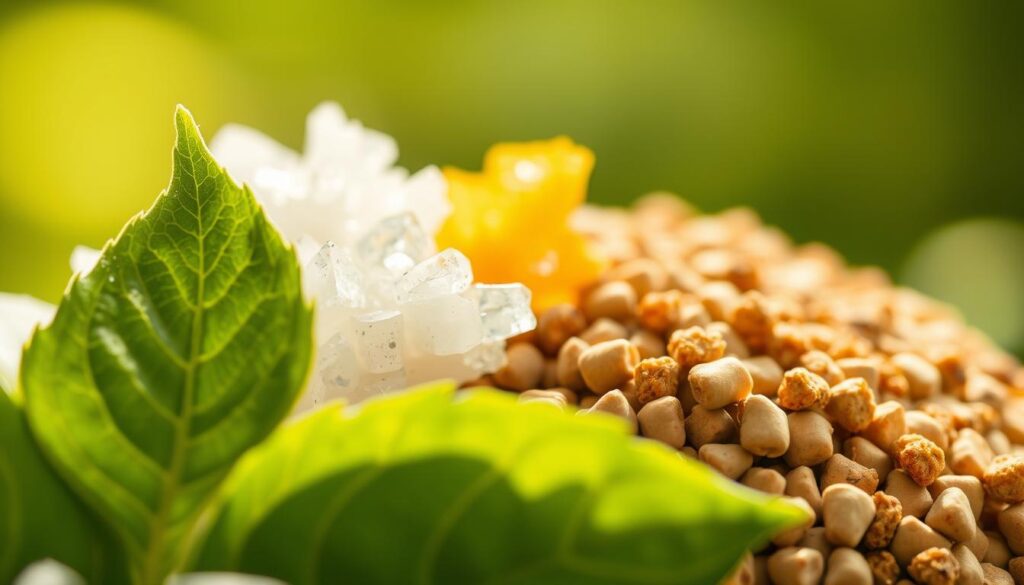
- Regulating water balance through stomatal opening and closing
- Supporting enzyme functions and nutrient transport
- Enabling energy conversion through ATP
- Promoting healthy root development and flower, fruit, and seed production
Knowing the importance of primary and secondary nutrients helps plants thrive. A balanced diet is key for healthy growth and avoiding deficiencies.
Understanding Micronutrients in Plant Nutrition
Micronutrients are key elements for plant health. They include boron, chlorine, manganese, iron, zinc, copper, and molybdenum. These nutrients are needed in smaller amounts than macronutrients but are vital for plant growth.
Micronutrients help with photosynthesis, nutrient uptake, and enzyme activity. For instance, iron is crucial for making chlorophyll. Zinc helps with protein making and enzyme control. Without enough micronutrients, plants can suffer from stunted growth, yellow leaves, and lower yields.
For plants to grow well, they need a balanced mix of nutrients. This includes both macronutrients and micronutrients. Knowing how important micronutrients are can help you ensure your plants get what they need for healthy growth.
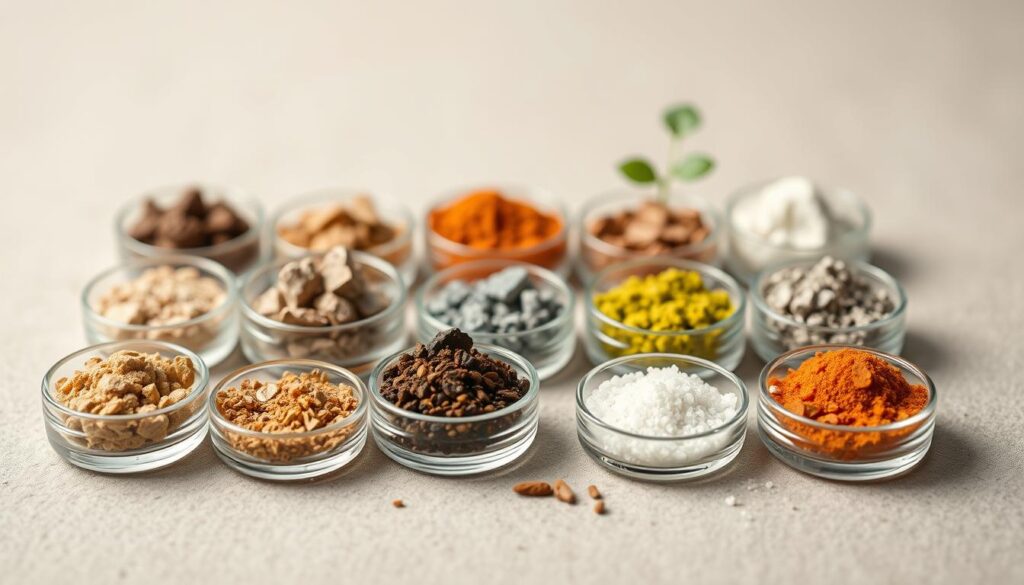
The following table highlights the importance of micronutrients in plant nutrition:
| Micronutrient | Function | Deficiency Symptoms |
|---|---|---|
| Iron | Chlorophyll production | Yellowing leaves, stunted growth |
| Zinc | Protein synthesis, enzyme regulation | Stunted growth, reduced yields |
| Manganese | Photosynthesis, enzyme activity | Yellowing leaves, reduced growth |
By understanding the role of micronutrients, you can help your plants grow strong and healthy. This ensures they get all the essential nutrients they need.
Water’s Role in Plant Nourishment
Water is key in plant care. It carries nutrients from the soil to the plant. This helps with nutrient transport and supports plant cells.
The xylem carries water and nutrients from the roots to the plant. The phloem moves substances made during photosynthesis.
When watering plants, think about how often and how. Smaller plants like succulents need more water than big ones. Hand watering works for small gardens, while big gardens use irrigation systems to save water.
Water plants when the soil is almost dry or when they start to wilt. This helps them absorb water better.
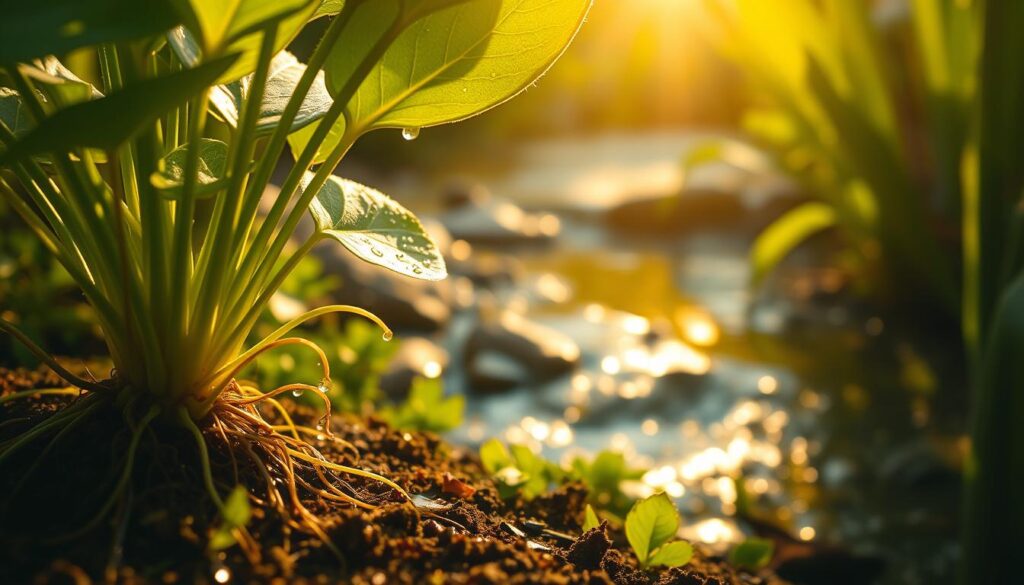
Watering regularly affects plant growth and nutrient uptake. Plants are mostly water, losing a lot through transpiration. To water right, follow these tips:
- Check the soil moisture levels regularly
- Water plants when the soil is close to dry or when they begin to wilt
- Use efficient irrigation systems to reduce water usage
Understanding water’s role in plant nourishment helps plants grow well. Proper watering is key for plant health and well-being.
Environmental Factors Affecting Plant Nutrition
Exploring plant nutrition, it’s key to know how the environment affects plants. Things like light, temperature, and humidity are crucial. They can change how plants get the nutrients they need to grow.
Temperature affects how plants make food through photosynthesis. Each plant type has its best temperature. Also, humidity levels matter because plants need moisture to take in nutrients from the soil. Knowing how these factors work together with plant nutrition is important for healthy growth.
Some important environmental factors for plant nutrition are:
- Light intensity and duration
- Temperature fluctuations
- Humidity levels
- Soil composition and pH
These factors can change how plants get nutrients like nitrogen, phosphorus, and potassium. These nutrients are essential for growth. By understanding these relationships, you can improve growing conditions and help your plants thrive.
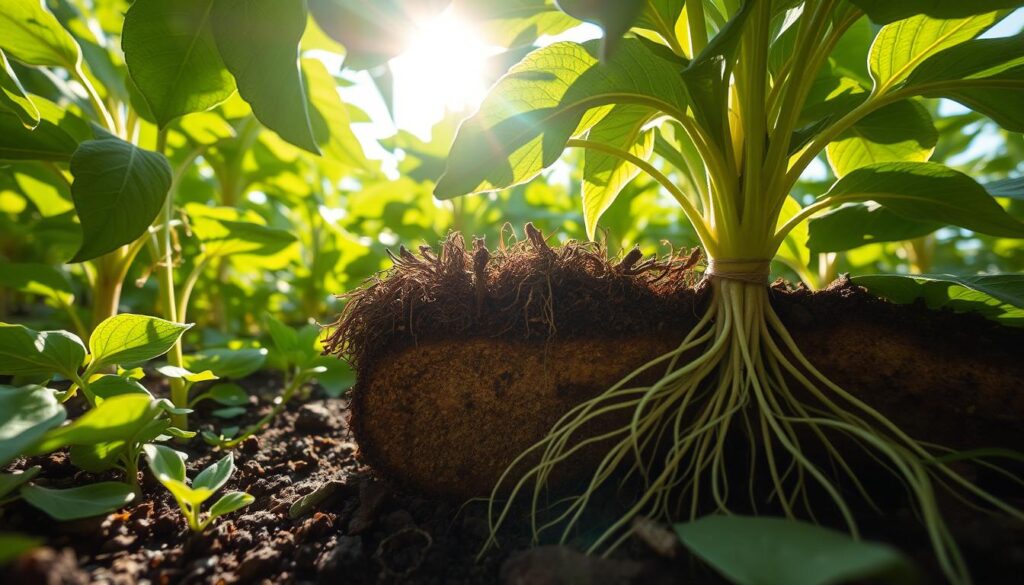
Knowing how the environment affects plant nutrition helps you make better choices for your plants. Whether you’re experienced or new to gardening, grasping these complex relationships is vital for success.
Signs of Nutrient Deficiency in Plants
Keeping a close eye on your plants can help you identify any nutrient deficiencies early on. Visual symptoms like yellowing leaves, stunted growth, and discoloration can all be signs that your plants aren’t getting the essential nutrients they need. Common deficiencies include nitrogen, phosphorus, and potassium, as well as issues with micronutrients like iron and boron.
of nutrient deficiency>
If you notice any of these telltale signs, don’t panic – there are plenty of treatment options available. Adjusting your watering, adding the right fertilizers, or amending your soil can all help restore your plants to their healthy, vibrant selves. With a little TLC and close observation, you can ensure your greenery stays thriving for years to come.
FAQ
How do plants get the nutrients they need to grow?
Plants get nutrients in several ways. They absorb them through their roots and photosynthesis. The roots take in essential nutrients from the soil. Photosynthesis turns light into chemical energy, which plants use for growth.
What is the importance of plant nutrition?
Plant nutrition is key for healthy growth and productivity. Nutrients like nitrogen, phosphorus, and potassium help plants grow. They also support photosynthesis and disease resistance.
What is the role of photosynthesis in plant nutrition?
Photosynthesis is vital for plant nutrition. It turns light into energy for the plant. This energy is used for growth and health.
How does the plant root system contribute to nutrient absorption?
The root system is crucial for nutrient absorption. It has tiny hairs that increase the surface area for nutrient uptake. The roots also release substances that help dissolve nutrients.
What are the essential macronutrients and micronutrients for plant growth?
Macronutrients include nitrogen, phosphorus, and potassium. Secondary nutrients like calcium and magnesium are also important. Micronutrients, such as iron and zinc, play key roles in plant health.
How does water affect plant nutrition?
Water is vital for plant nutrition. It helps transport nutrients and supports cell functions. Proper water levels ensure plants can absorb and use nutrients effectively.
What environmental factors can impact plant nutrition?
Environmental factors like light and temperature affect plant nutrition. Changes in light levels impact photosynthesis. Temperature and humidity also influence nutrient uptake.
How can I identify and address nutrient deficiencies in my plants?
Look for signs like discoloration and stunted growth to spot nutrient deficiencies. Recognizing these signs helps address imbalances. Adjusting soil, using fertilizers, or changing the environment can help.
Table of Contents
Source Links
- https://theconservationfoundation.org/how-healthy-soil-makes-healthy-plants-and-ecosystems/ – How Healthy Soil Makes Healthy Plants and Ecosystems – The Conservation Foundation
- https://www.nofamass.org/articles/2022/05/how-do-plants-get-their-nutrition/ – How Do Plants Get Their Nutrition?
- https://npk-industries.com/blogs/the-npk-blog/nutrient-management-101-the-basics-for-healthy-thriving-plants?srsltid=AfmBOoocDKaCmU78hPmhbx9ykSecZtdr5Sz8ALR5q6WQXsUpQmETzLQr – Nutrient Management 101 | The Basics for Healthy, Thriving Plants
- https://miraclegro.com/en-us/growing-with-martha-stewart/Ask-martha-feeding-your-plants-a-guide-to-the-basics.html?srsltid=AfmBOorkwrYS6u_EGyzz07mvdiyNQmJlbmsD_o39B9VbBuvmbZVVLGie – Ask Martha: Feeding Your Plants – A Guide to the Basics
- https://bio.libretexts.org/Bookshelves/Introductory_and_General_Biology/General_Biology_(Boundless)/31:_Soil_and_Plant_Nutrition/31.01:_Nutritional_Requirements_of_Plants/31.1A:_Plant_Nutrition – 31.1A: Plant Nutrition
- https://www.britannica.com/science/photosynthesis – Photosynthesis | Definition, Formula, Process, Diagram, Reactants, Products, & Facts | Britannica
- https://www.geeksforgeeks.org/nutrition-in-plants/ – Nutrition in Plants – Autotrophic and Heterotrophic Nutrition | %%sitename%% – GeeksforGeeks
- https://eclassopedia.com/how-do-plants-make-food-understanding-photosynthesis-in-simple-terms/?srsltid=AfmBOop9YmDbbReXDldN0AvnhAzc33WQOY3x5EiUjbxZymsrSQquvbMG – How Do Plants Make Food? Understanding Photosynthesis
- https://www.discovermagazine.com/planet-earth/how-does-photosynthesis-work – How Does Photosynthesis Work?
- https://sciencegeeks.co.uk/photosynthesis – Photosynthesis Explained | How Plants Make Their Own Food | SCIENCE GEEKS
- https://atami.com/blog/cultivation/understanding-the-root-zone-of-plants-a-comprehensive-guide-to-cultivating-a-strong-root-system/ – Understanding the Root Zone of Plants – A Comprehensive Guide to Cultivating a Strong Root System
- https://showme.missouri.edu/2024/plant-roots-under-drought-no-longer-the-hidden-half/ – Plant roots under drought – no longer the hidden half
- https://extension.umn.edu/news/soil-health-key-healthy-plants – Soil health is key for healthy plants
- https://www.agrology.ag/blog-soil-life-nutrient-density – Soil Life – The Secret to Nutrient-Dense Crops — Agrology
- https://cropwatch.unl.edu/2024/how-does-soil-life-contribute-soil-health/ – How Does Soil Life Contribute to Soil Health? | CropWatch
- https://bio.libretexts.org/Bookshelves/Introductory_and_General_Biology/General_Biology_(Boundless)/31:_Soil_and_Plant_Nutrition/31.01:_Nutritional_Requirements_of_Plants/31.1C:_Essential_Nutrients_for_Plants – 31.1C: Essential Nutrients for Plants
- https://www.britannica.com/science/nutrition/Nutrition-in-plants – Nutrition – Photosynthesis, Macronutrients, Micronutrients | Britannica
- https://www.homesandgardens.com/gardens/essential-plant-nutrients – What essential plant nutrients are needed for growth? 17 key elements that help your garden thrive
- https://www.sound.ag/blog/micronutrients-small-but-mighty – Essential Plant Micronutrients for Crop Yield
- https://extension.oregonstate.edu/gardening/techniques/guide-understanding-fertilizers – A guide to understanding fertilizers
- https://arkaspr.com/blog/unlocking-the-secrets-of-plant-nutrition-a-guide-to-micro-and-macro-nutrients/ – Unlocking the Secrets of Plant Nutrition – ARKA SPR
- https://atami.com/blog/cultivation/the-importance-of-water-in-plants-and-what-to-consider/ – The Importance of Water in Plants and What to Consider
- https://bokashiearthworks.net/understanding-water-and-nutrient-uptake-in-plants/ – Water & Nutrient Uptake in Plants: Essential Mechanisms Guide
- https://magazine.publichealth.jhu.edu/2024/less-nutritious-crops-another-result-rising-co2 – Less Nutritious Crops: Another Result of Rising CO2 | Hopkins Bloomberg Public Health Magazine
- https://www.environmentenergyleader.com/stories/how-climate-change-reduces-plant-nutrition-and-food-security,61058 – How Climate Change Reduces Plant Nutrition and Food Security – Environment+Energy Leader
- https://extension.oregonstate.edu/gardening/techniques/environmental-factors-affecting-plant-growth – Environmental factors affecting plant growth
- https://extension.uga.edu/publications/detail.html?number=B1569&title=nutritional-deficiencies-in-vegetables – Nutritional Deficiencies in Vegetables
- https://www.nparks.gov.sg/publications-resources/articles/identifying-nutrient-deficiency-in-plants – Identifying Nutrient Deficiency in Plants

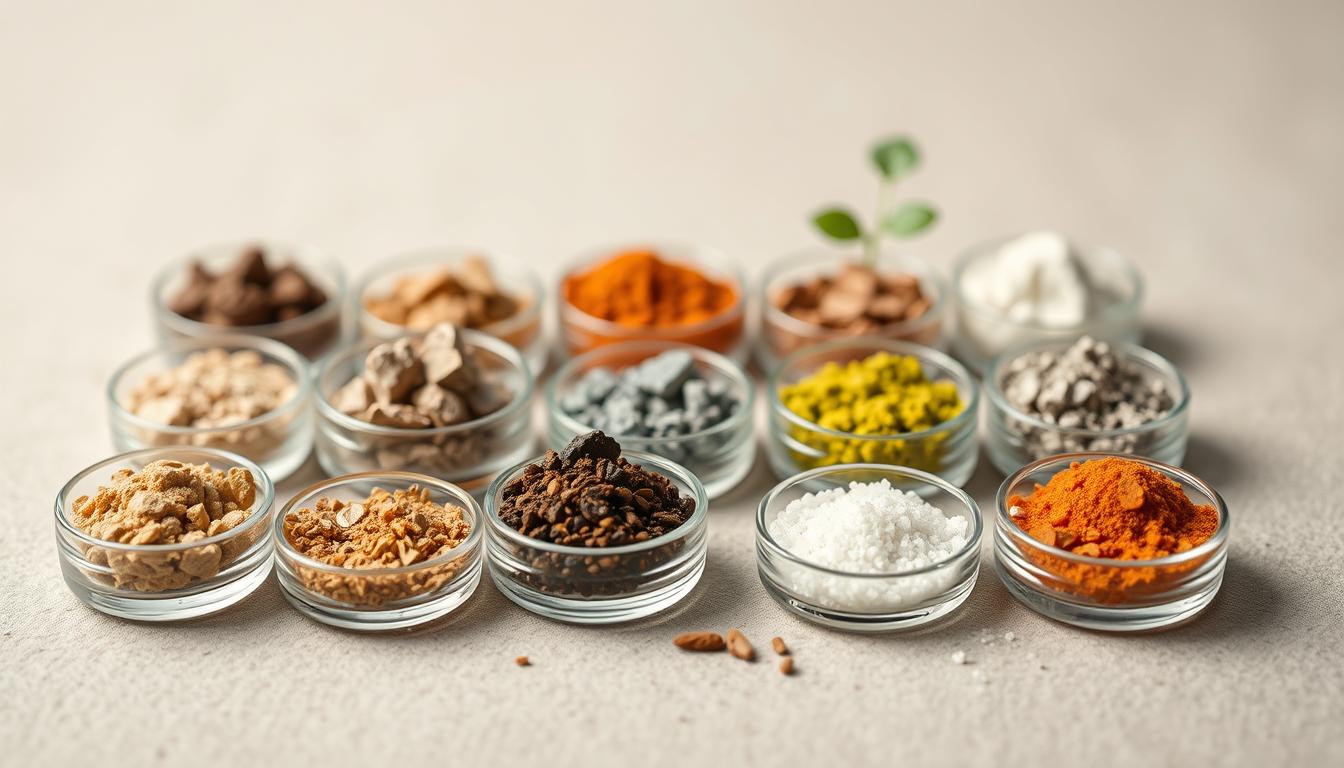
1 thought on “The Secret to How Plants Get Nourishment”